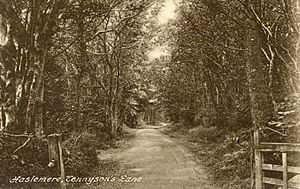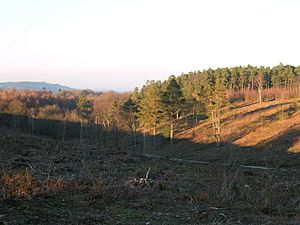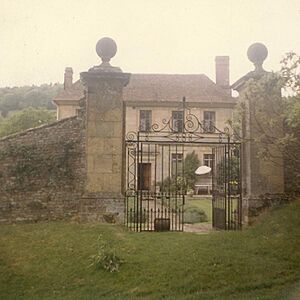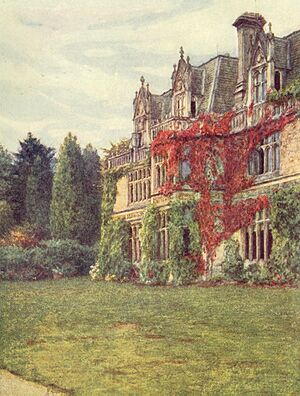Blackdown, West Sussex facts for kids
Quick facts for kids Blackdown |
|
|---|---|
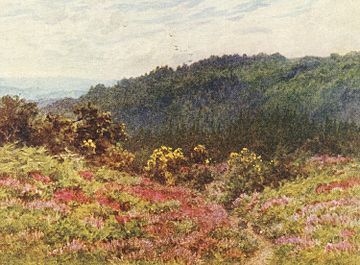
View of Blackdown, painted by Helen Allingham, 1902
|
|
| Highest point | |
| Elevation | 279.7 m (918 ft) |
| Prominence | 191 m (627 ft) |
| Parent peak | Leith Hill |
| Listing | Marilyn, County Top |
| Geography | |
| Location | Western Weald, South Downs National Park, England |
| Parent range | Greensand Ridge (broken range) |
| OS grid | SU919296 |
| Topo map | OS Landranger 197, Explorer OL33 |
| Climbing | |
| Easiest route | Public transport: pavement and footpath along Tennyson's Lane, Haslemere; 3 car parks at Tennysons Lane (to north), 1 at Ferndens Lane (to south) |
Blackdown, also known as Black Down, is a tall hill in England. It stands about 280 meters (919 feet) high. This makes it the highest point in the historic county of Sussex and also in the beautiful South Downs National Park. It's one of the highest spots in the southeast of England, though a couple of other hills like Walbury Hill and Leith Hill are a bit taller. Blackdown is a protected area, cared for as part of the South Downs National Park.
Contents
Where is Blackdown Located?
Blackdown is found in the very north of West Sussex. The hill looks like a dark, towering shape. It stands high above the western parts of the Low Weald and southwest Surrey. There are no villages directly on Blackdown. However, it is about two miles from the town of Haslemere. It is also near Fernhurst and Lurgashall.
Getting to Blackdown
You can find three car parks run by the National Trust on Tennyson's Lane. This lane goes up Haste Hill from Haslemere. Many footpaths lead to Blackdown from nearby villages. One path is a steep climb up the southern side from Lurgashall. The Sussex Border Path and the Serpent Trail also cross Blackdown.
Tennyson's Lane is named after a famous poet who lived here. It's a sunken lane, almost like a tunnel made by trees. It goes from Haslemere, past Aldworth House, to near the top of the hill. In 1905, someone described it well: "Trees meet overhead, copsewood surrounds it... It twists and turns, and to the stranger appears to lead nowhere in particular."
Nature and Wildlife at Blackdown
Blackdown is part of the Greensand Ridge in terms of its geology. The sandy, acidic soil here means only certain types of plants can grow. A long time ago, Blackdown was a common area where sheep grazed. This kept trees from growing tall, and heather was everywhere.
After grazing stopped, Scots Pine trees became very common. Now, the National Trust works to cut down some trees and do controlled burning. This helps to bring back the open heathland. The area is also fenced so that cattle can graze. This helps manage the land naturally. Blackdown is a very important home for many insects and birds.
The National Trust owns the slopes covered in pine trees and heather. There are many paths for walking and organized walks. These are supported by volunteers and local groups. The northern part of the hilltop has small, old sand and gravel pits.
Forests and Woodlands
To the north, you'll find large woods like Homewood, which is partly in Surrey. There's also Jays Wood and Abester's Copse on the eastern slope. Other woods include Quellwood Common, Quell Copse, and Windfell Wood. On the south side, there are Leazers Wood, Bridge Reeds, Sheetland, and Lye Wood. Alder and Chase Woods are also found south of the town.
You can see a model of Blackdown's geology at the Haslemere Educational Museum. The museum also has lots of information about the area's natural history.
Blackdown's Past
Tools made of flint show that people lived on Blackdown a very long time ago. This was during the Mesolithic period, around 6000 BC. The name of an old path, pen-y-bos, comes from the ancient British language. This is similar to the well-known pen-y-ghent in Yorkshire.
Early Owners and Iron Production
The ownership of Blackdown Estate can be traced back to the 1300s. The Yaldwyn family owned it for many generations. William Yaldwyn the elder took over the property in 1600. He worked hard to use the land for business. In 1627, he gained the right to buy all the iron ore from the Petworth Estate. This made him very rich. By 1640, he finished building the main part of the current Blackdown House.
During the English Civil War (1642–1651), there was a huge need for iron. It was used to make weapons and supplies. It is said that Oliver Cromwell stayed at Blackdown House. This was probably around 1644–45, when Cromwell was helping in the war in western England. The room where Cromwell slept is still called the Oliver Cromwell bedroom.
In 1807, when Richard Yaldwyn died, the Blackdown Estate was very large. It included Blackdown and many other farms. Many members of the Yaldwyn family are buried at St. Laurence's church in Lurgashall.
In 1944, the owner, W. E. Hunter, gave Blackdown to the National Trust. He did this to remember his wife. A stone seat at the Temple of the Winds remembers the Hunters. Today, the National Trust manages Blackdown. They get help from the Blackdown Committee.
Buildings and Architecture
You can see many interesting buildings around Blackdown. Aldworth House and Foxholes were part of the estate of Alfred, Lord Tennyson. You can also see buildings in Victorian and Arts and Crafts styles. These include Blackdown House to the west, which is surrounded by daffodils in spring. To the east, there is Old Manor Farm.
Because Blackdown is so high up, it was once home to a special station. From 1796 to 1816, it had a shutter telegraph chain station. This station sent messages between the Admiralty in London and the Royal Navy in Portsmouth.
Lord Tennyson's Home
Besides its height and beauty, Blackdown is famous for being the home of the poet Alfred, Lord Tennyson. He had two houses here: Aldworth and Foxholes. Tennyson wanted to get away from the many visitors who came to his home on the Isle of Wight. So, he bought land on Blackdown and built Aldworth in 1869.
The house was designed in a French Gothic revival style. It was built using local sandstone. Aldworth sits on a ridge with amazing views over the Weald. Lord Tennyson used it as his summer home. He loved taking long walks all over Blackdown. A painter named Helen Allingham often visited him. Her pictures of The homes of Tennyson show the landscape very well. Lord Tennyson passed away in the house on October 6, 1892.
Blackdown Air Crash
On November 4, 1967, an airplane called Iberia Airlines Flight 062 crashed into Blackdown Hill. The plane was flying from Málaga, Spain, to London Heathrow Airport. It was a Sud Aviation Caravelle with 37 people on board. Sadly, everyone on the plane died when it hit the southern slope of Blackdown Hill.
Images for kids



